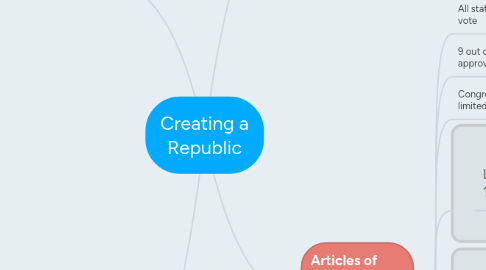
1. Constitutional Convention
1.1. Virginia Plan
1.1.1. plan at the Constitutional Convention that called for a strong national government with three branches and a two-chamber legislature.
1.2. New Jersey Plan
1.2.1. plan at the Constitutional Convention favored by smaller states, that called for three branches of government with a single-chamber legislature.
1.3. 3 branches of government
1.3.1. Executive
1.3.2. Judicial
1.3.3. Legislative
1.4. Great Compromise
1.4.1. plan at the Constitutional Convention that settled the differences between large and small states
1.5. Three-Fifths Compromise
1.5.1. agreement at the Constitutional Convention that three-fifths of the slaves in any state be counted in its population
1.6. Separation of Powers
1.6.1. an act of vesting the legislative, executive, and judicial powers of government in separate bodies.
2. Federalists Vs. Anti-Federalists
2.1. 9 of 13 states had to ratify Constution
2.2. Federalists = supported strong central government
2.2.1. James Madison, Alexander Hamilton, and John Jay wrote the Federalist Papers to explain and defend the Constitution
2.3. Anti-Federalists = wanted a Bill of Rights
2.4. Bill of Rights
2.4.1. A bill of rights was needed to protect such basic liberties as freedom of speech and religion.
2.5. 10 of the 12 amendments
3. Articles of Confederation
3.1. All states have the right to vote
3.2. 9 out of 13 states had to approve any changes
3.3. Congress' power was limited
3.4. Land Ordinance of 1785
3.4.1. Law passed by Congress that allowed for sales of land in the Northwest Territory and set up standards for land sal
3.5. Northwest Ordinance of 1787
3.5.1. A law passed in 1787 to regulate the settlement of the Northwest Territory, which eventually was divided into several states of the Middle WestA law passed in 1787 to regulate the settlement of the Northwest Territory, which eventually was divided into several states of the Middle Wes
3.6. Shay's Rebellion
3.6.1. An uprising led by a former militia officer, Daniel Shays, which broke out in western Massachusetts in 1786. Shay's followers protested the foreclosures of farms for debt and briefly succeeded in shutting down the court system.
4. Constitutional Influences
4.1. Admired the Roman Republic
4.1.1. the Founding Fathers saw the collapse of Rome's republic as a warning to the United States.
4.2. English Bill of Rights
4.2.1. The English Bill of Rights said that elections should be held regularly
4.3. Habeas Corpus
4.3.1. he idea that no person could be held in prison without first being charged with a specific crime.
4.4. Magna Carta
4.4.1. made it clear that English monarchs themselves had to obey the law.
4.5. European Enlightenment
4.5.1. They saw the Constitution as a contract between the people and their government.

